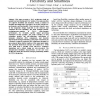Free Online Productivity Tools
i2Speak
i2Symbol
i2OCR
iTex2Img
iWeb2Print
iWeb2Shot
i2Type
iPdf2Split
iPdf2Merge
i2Bopomofo
i2Arabic
i2Style
i2Image
i2PDF
iLatex2Rtf
Sci2ools
ISCAS
2007
IEEE
2007
IEEE
Parallel current-steering D/A Converters for Flexibility and Smartness
—This paper presents a DAC architecture built on parallel current-steering sub-DAC entities. Two main novelties are explored: flexibility and smartness. Firstly, a number of available operating modes (op-modes) can set the overall DAC performance and functionality. These op-modes transfer some of the important design trade-offs to the end-user and constitute the DAC flexibility. The main examples include: resolution-power-number of DACs, static-dynamic performance, etc. Secondly, specific signal processing techniques become possible. The main examples of such techniques include: full self-calibration, cancellation of harmonic distortion (HD) components, and linearity improvement through redundancy. This paper concentrates on a method to suppress undesired HD components through DA processing of phase shifted replicas of the main input signal. The presented theoretical concepts are realized in a 14-bit DAC built from 4 parallel 12-bit sub-DACs. Transistor simulations and a layout desig...
| Added | 04 Jun 2010 |
| Updated | 04 Jun 2010 |
| Type | Conference |
| Year | 2007 |
| Where | ISCAS |
| Authors | Georgi I. Radulov, Patrick J. Quinn, Pieter Harpe, Hans Hegt, Arthur H. M. van Roermund |
Comments (0)

